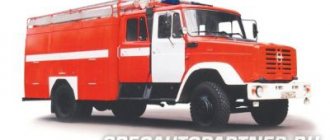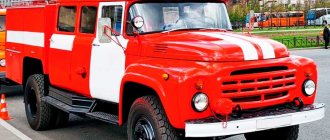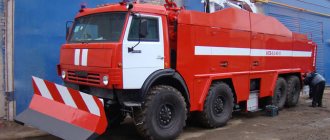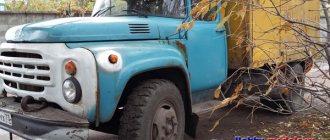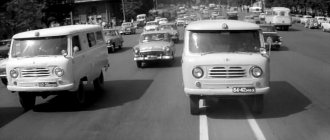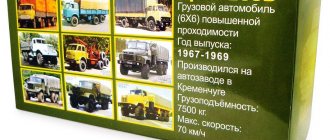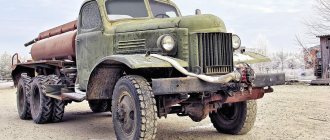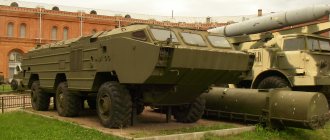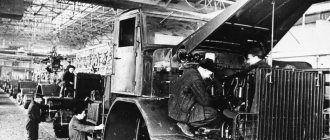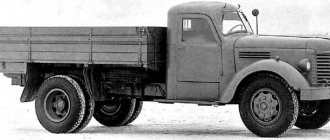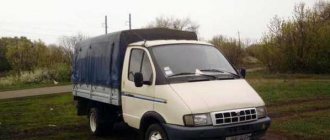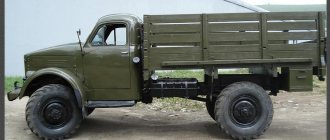Fire hose trucks carry out the task of delivering up to 5000 m of fire hoses to the fire zone, their mechanized laying and cleaning of main lines. They are used to supply volumes of water and fire extinguishing agents at a considerable distance. Compatible with other technical means that support the work of fire brigades in the area of major accidents: mobile pumping stations, tank trucks and ANR.
According to GOST R 53247-2009, a hose fire truck is classified as special equipment. The specifics of its operation become the determining factor in the re-equipment of base machines. A prerequisite is an all-wheel drive chassis, thanks to which you can implement the function of rolling out lines while the car is moving. Due to the significant footage of the hoses included in the kit, the main equipment includes a mechanism for rolling and loading them. Then they, folded like an accordion, are transported in special compartments of the body or on the roof of the AR. A prerequisite is the presence of ventilation under the body.
Today, the Ministry of Emergency Situations is armed with AR-2 hose fire trucks on ZIL, Ural and KamAZ chassis.
Fire hose vehicles
The AR-2 fire truck is used to extinguish fires at enterprises and urban facilities. Hose lines are laid directly from the pumping station to the site of the fire, which makes it possible to effectively cope with various types of ignitions.
AR-2 (KAMAZ-43502)
History of creation
The fire hose truck first appeared in the 1920s in fire garrisons in Moscow and Leningrad. Its appearance here is explained by the fact that during large fires a sufficient supply of hoses is needed, and it is impossible to provide it only with standard fire engines.
It was decided to allocate a special transport that will be responsible for supplying hoses to the source of ignition. At first, standard trailers were used. After some time, ordinary trucks, converted to transport hoses, began to operate.
On a note. During the war, hose fire engines were equipped with equipment that is unusual for the present time - armored shields. It was they who made it possible to lay sleeves during combat operations.
In the 50s of the last century, the first specialized AR-2s on the ZIS-150 chassis were produced.
Purpose
AR-2 is used for installing and winding up hose lines, eliminating fires at enterprises and large facilities in populated areas.
The temperature during operation of such a vehicle should be normal from –45 to +40 °C. It is permissible to use the AR-2 off-road and in bad weather.
Tasks of the fire hose truck:
- Lay a hose line from the water source to the fire site.
- Provide a sufficient number of hoses for large and long-lasting fires.
- Roll up the hoses and transport them back to the fire department.
Models
Some of the most famous AR-2 models include:
- AR-2 (ZIL-131). Delivery of the fire department and laying of hoses (diameter 150, 100 or 77 mm) to the fire site.
- AR-2 (Ural-5557). A firefighting vehicle with hoses that is used to extinguish large fires. The fire department's weapons are firmly fixed in the body using clamps.
- AR-2 (KAMAZ-43502). The frequently used AR-2 model on the KamAZ chassis.
AR-2 (ZIL-131)
Fireman zil 130
Production of AC 40 tank trucks began in the 1970s. Fire trucks 130 are designed to deliver a team of 7 firefighters and the necessary equipment to the scene of a fire.
Fire tanker AC 40 130
The fire tanker is manufactured on the basis of ZIL trucks, on the platform of which special equipment is installed.
The ZIL vehicle base is unpretentious in operation and maintenance. Also, the tanker can be used in different climatic conditions; due to its maneuverability, it can be placed in the required position; its compactness allows it to extinguish fires in urban conditions, where free space is limited.
Repairing a ZIL car is inexpensive, and maintenance can be carried out by full-time mechanics.
A common brand is the ZIL 130 fire truck. 10 models of these vehicles were produced. A popular model is the ZIL ac 40 130 63b. This is an improved version of the 63A model. In the new model, the pressure pipes are placed inside the superstructure. This brand is equipped with a tank with a volume of 2360 liters and an additional tank for foam concentrate. The cabin is an all-metal structure with 2 rows of seats. On the roof there are canisters in which fire hoses are stored. Quick exit of firefighters from the vehicle is ensured by 4 cabin doors.
Specialized equipment is located in body compartments. There is a centrifugal pump at the rear of the car.
The rear wheels of the AC 40 130 63b are made in a dual-slope configuration, which ensures road stability and high cross-country ability of the tanker. For driving in rural areas, you can install arched tires. There is a power steering.
Changes were also made to the chassis. The tanker was produced with the brake system of KAMAZ trucks. Due to the fact that it was necessary to fill the brake system with air, the departure of the tanker truck was delayed.
The engine is 4-stroke, gasoline, V-shaped, installed in front of the cabin. Air is supplied to the engine through an air duct, which is connected to the air filter by a corrugated pipe.
In the 1980s, a batch of machines equipped with the German Magirus P516H pump was produced.
Specifications
In 1968, the AC 40 131 model was developed, based on the ZIL truck. During production, the machines were modernized and improved. All changes improved various qualities of the car.
Technical characteristics and description of ZIL 131:
- type of chassis used - ZIL 131;
- wheel formula - 6*6;
- single-pitch wheel configuration;
- carburetor engine type;
- engine power - 110 kW, 150 hp;
- 7 seats;
- curb weight of the car - 11050 kg;
- water-foam extinguishing system;
- tank capacity - 2400 liters;
- foam concentrate capacity - 150 liters;
- monitor type - PLS-P 20 with foam nozzle;
- continuous foam supply time - 20 l/s;
- manual control of the monitor;
- water jet supply range - 50 m, foam jet - 60 m;
- the pump compartment is heated by exhaust gases;
- There is space for a radio station.
- maximum speed - 80 km/h;
- electric or gas siren;
- fire pump P N 40 UV.
Basic chassis
In the production of tank trucks, an important step is the selection of the chassis, since this set of units determines the functionality of the fire truck. The car chassis consists of 3 parts:
- Transmission.
- Chassis.
- Control mechanism.
There are 2 chassis schemes:
- The frame chassis consists of beams on which all machine components are installed. The frame design allows you to transport large loads.
- Load-bearing body. In order to reduce the weight of the car, the functions of the frame are transferred to the body. This design increases travel speed and provides comfort, but does not allow for the transport of large loads.
Frame structures are:
- spar;
- spinal;
- peripheral;
- lattice.
For the manufacture of vehicles, all-wheel drive and all-wheel drive truck chassis are used. All-wheel drive vehicles are equipped with tires for driving on dirt roads and on flat surfaces. It should also be possible to install anti-slip chains on the drive wheels.
The chassis of the ZIL fire truck has a spar frame and an increased level of reliability. The integrity of the supporting structure, when the machine is fully loaded, is ensured by special inserts that reinforce the side members.
The suspension can be dependent or independent. The main purpose of the suspension is to absorb vibrations while driving. The wheelbase consists of 6 driving wheels.
Pumping units were also produced on such chassis, which were replaced by ZIL fire trucks.
Design features of AR-2
The design elements of fire hose vehicles are the chassis and body, PPR (pressure fire hoses), a control system for transport and other mechanisms, and electrical devices.
Chassis
The chassis used to construct the hose car must be all-wheel drive. This allows hose lines to be laid while traffic is moving.
The following is also installed on the electrical equipment of the base chassis:
- headlight signal, headlight spotlight;
- taillight;
- body lighting;
- lights on the body.
Body
The fire truck body with hoses is attached to the chassis. Inside there are six sections into which the wound sleeves are folded. The center section serves as a passageway when laying hose structures.
There is a fire monitor on the roof of the body. In order to climb to it, use a ladder that is installed in front of the body.
There are rear and side folding exits. On the side of the lower compartments there are also doors with special descent steps, which are intended for emergency descent.
Fire hoses
Rear curtain passages are used to lay the hose line. The installation can be carried out directly while the vehicle is moving, but provided that first gear is engaged.
Attention! It is permissible to use a monitor mounted on top of the body together with a pumping station when extinguishing a fire. This speeds up the work of the CPD.
After fire extinguishing is completed, the NPR line is divided into hoses. Then, using a winding device, it is returned to the back of the fire truck.
Electrical equipment
The complex of electrical devices of a fire truck with hoses includes:
- chassis;
- device for winding and unrolling sleeves;
- Remote Control;
- lighting mechanisms.
The fire truck is powered by 24 V DC.
AR-2 (Ural-5557)
From small workshop to large-scale production
Today PC "Pozhmashina" continues to develop and manufacture fire fighting equipment: both simple tank trucks and complex specialized fire fighting vehicles. Over the years of its existence, the plant experienced ups and downs, was at the peak of its glory and fell into decline.
The founding date of the enterprise is September 6, 1928. Over the course of 10 years, large-scale production was built on the basis of small workshops. The first products were flashlights and fire extinguishers. Gradually, sliding three-legged ladders, assault ladders were mastered, and before the war, the production of automobile bodies. The number of workers at the enterprise at the end of the 1930s was 1,500 people.
With the outbreak of war in 1941, the plant was evacuated to the Urals, Chelyabinsk region. Previously, history has known many examples of the resettlement of peoples, but never before in any country in the world have there been examples of the mass evacuation of key industries to another point in the world. Thus, in Chelyabinsk Shadrinsk and the village of Shchuchye (later Shchuchansky Fire Engineering Plant, Kurgan Region), the production of first military products and then fire extinguishers was organized. After the war, the company began producing fire trucks.
Technical characteristics of AR-2
Technical data about the AR-2 device includes information about the type and power of the built-in engine, permissible speed of movement, pressure hoses, etc.
The performance characteristics of AR-2 (KAMAZ-43114)-55VR are given in the table.
| Chassis | KamAZ-43114 (6x6) |
| Engine | diesel |
| Power | 176 kW |
| Speed | 90 km/h |
| Places | 3 |
| Pressure hoses (77 mm) | 1 200/60, m/pcs. |
| Pressure hoses (150 mm) | 800/40, m/pcs. |
| Monitor consumption | 40 l/s |
| Sleeve winding | mechanized |
| Weight | 15 100 kg |
| Dimensions, mm | 8 100×2 500×3 450 |
1970–1980
During the period of stagnation, the production of the firefighting all-terrain vehicle VPL (71)-149 was mastered for extinguishing forest fires on the basis of the medium tracked transporter-snow and swamp-going vehicle GT-SM (GAZ-71, later GAZ-3403). For airfield services, production of the airfield service fire truck AA-60(543)-160, developed at OKB-8, began. In 1979, the production of fire trucks amounted to 3,135 units, i.e., more than 11 vehicles were produced every working day (excluding holidays).
AR-2 equipment
The AR-2 package includes the following components:
- Set of additional parts and tools.
- Spotlight.
- Lanterns.
- Sleeves (77 and 150).
- Blowtorches.
- Three pairs of protective gloves and boots.
- Air-foam fire extinguishing device.
- Rope 25 meters long.
- RT-80 branching.
- Two wheel chocks.
- 8 hose fasteners (ZR-80, ZR-150).
- Heater for hose joints.
- Overlapping mechanism.
- 8 sleeve delays (77 and 150).
- Stock of sets of devices and structural parts.
Attention! Depending on the model, some parameters and configuration options for the AR-2 change. Example: AR-2 (131)133 may be equipped with:
- 67 NPR, d=150 mm, length=1,340 m;
- 88 NPR, d=110 mm, length=1,760 m;
- 102 NPR, d=77 mm, length=2,040 m.
Photos of all models and decoding of their performance characteristics can be found on the Internet.
2012–2018
The production of fire fighting equipment has been reoriented to foreign chassis, as well as the chassis of KrAZ and MAZ vehicles. Mastered in production are AC-18(LPT-613)-411, AC-4-60(5401NE)-515K, AC-4-40(5309)-505M. The first fire ladder truck on a foreign chassis was the AL-30(HD120)-512H, it was assembled in the summer of 2022, and was first presented to residents of the village and guests at the celebration of the 90th anniversary of the plant. In 2022, the company changed its logo. In search of our own emblem, we chose an example from the animal world. If Bronto has a brontosaurus in its logo, Ladan’s products now have an image of an elephant.
Advantages of AR-2
Fire hose vehicles have reliably proven themselves when extinguishing fires at large facilities. The main advantages of using technology:
- Main hose lines can be laid over long distances, which means it simplifies the connection between the water source and the fire site.
- When extinguishing fires, hoses of various diameters are used depending on the terrain and type of structure.
- With the help of hoses, large amounts of extinguishing agent can be supplied almost uninterruptedly over distances.
The advent of fire hose vehicles greatly simplified the work of fire departments. Now there is no need to use additional fire fighting equipment to transport hose devices, which significantly speeds up the fire extinguishing process and makes it more efficient.
1990–2004
The production of the AP-4(43105)-222 powder car has been mastered. The NPTs-40/100 centrifugal pump and the NTsPK-40/100-4/400 combined pump entered mass production. Fire trucks on the GAZelle chassis ASh-6(32213)-275, APP-4(2705)-276 were put into serial production.
Design and operation of rifles of the AR-15/M16 family
AR-15/M16 rifles have an automatic system designed by Eugene Stoner, which works according to the scheme of removing part of the powder gases from the barrel bore into the receiver, through a hole in the barrel wall through a gas tube. During a shot, part of the powder gases is diverted from the barrel through a transverse hole into the gas block, which in most cases is also the base of the front sight. Next, the powder gases enter the gas outlet tube, made of stainless steel, which is located above the barrel. This tube goes directly into the receiver. In the receiver itself, the back of the gas tube fits into a nozzle located at the top of the bolt frame. From the gas outlet tube, powder gases pass through the channel of the nozzle into the internal cavity of the bolt frame. Powder gases expand inside this cavity and push the bolt frame back, but the bolt is pressed against the breech of the barrel, thereby somewhat weakening the load on the lugs, with the help of which the bolt engages with the breech of the barrel and locks its channel.
As the bolt carrier moves rearward, the interaction of its spiral groove with the cross pin rotates the bolt. When the bolt rotates, its lugs disengage with the barrel breech. Next, the bolt together with the bolt frame moves back, during the movement the spent cartridge is removed from the chamber and thrown out through the window in the receiver. At this time, the hammer is cocked and the return spring is compressed. After the bolt group reaches the rearmost position, if there are still cartridges in the magazine, under the action of the return spring it goes back forward, in the process sending the next cartridge from the magazine into the chamber. Closer to the extreme forward position, the bolt frame rotates the bolt, locking the barrel bore and stops in the extreme forward position until the next shot. Since the barrel bore is locked behind its breech, the receiver is not subject to loads during shooting and is therefore made of a light alloy based on aluminum that is less durable than steel, but has a lower mass.
The first rifles of the AR-15/M16 family and many modern variants have a black plastic forend, stock and pistol grip, which is why this weapon received the nickname “Black rifle” in the United States. However, today in the civilian arms market there is a wide selection of accessories for AR-15 type rifles with a huge number of options in size, configuration and color, which can be camouflage, dark green or sand. An aluminum forend with one, two, three or four Mil-Std 1913 Picatinny rails is becoming increasingly popular. Using these guides, a variety of accessories can be attached to the forend - tactical flashlights, bipods, front hold handles , laser target designators, various sights. There are two main types of stock - a permanent non-adjustable stock and a telescopic stock that is adjustable in length. Rifles with long barrels are mostly equipped with non-adjustable stocks, while carbines are equipped with adjustable stocks. The stocks themselves are also produced in a wide range of different designs.
The cocking handle has a T-shaped cross-section and is located in the rear of the receiver, above the butt. During firing, the cocking handle remains motionless. On the right side of the receiver there is a bolt rammer (forward assist), designed to manually close it if the force of the return spring is insufficient. The window for ejecting spent cartridges is closed by a spring-loaded dust curtain, which opens automatically when the shutter is cocked. Civilian versions of AR-15-style rifles are self-loading small arms that can only fire single shots and do not have the ability to fire in bursts.
A set of PWS upper receivers with gas piston gas systems for installation on any standard AR-15 rifle or carbine lower receiver.
A number of gun manufacturers now offer AR-15/M16 family rifles and carbines and separately sold upper receivers with a gas piston instead of a gas tube. This solution eliminates the most well-known drawback of the AR-15 family, which is the accumulation of carbon deposits in the bolt group and receiver due to direct gas exhaust when firing cheap, low-quality cartridges. The piston can have both a long and short stroke, and is located inside the forend above the barrel. When fired, the piston pushes the bolt frame back, acting on it with the help of a long rod. These designs are advertised by manufacturers as improved versions of the AR-15, which have significantly greater operational reliability, and in addition require less effort to clean and heat up less when firing. But there is a downside to this solution, which is that when using some conversion kits that have bolt carriers of the usual standard AR-15 family, increased loads begin to affect the receiver due to asymmetrical forces applied to the bolt carrier, and the tendency the bolt group to misalignment, which leads to accelerated wear of the receiver. The solution to this problem is the comprehensive use of components for converting a standard rifle into a “piston” rifle, for example, purchasing the upper part of the receiver complete with barrel, gas outlet assembly with gas piston and bolt group.
The trigger mechanism (trigger mechanism) of serial rifles of the AR-15 type is hammer-type, has a release without warning. Currently on the market there are match triggers for high-precision shooting, which have a trigger with warning and adjustment of its stroke and force. The manually operated safety lever is located on the left side of the lower part of the receiver. The safety positions are indicated as Fire (fire) and Safe (safety) - the safety is on. AR-15/M16 style rifles can be equipped with ambidextrous safety levers.
The receiver of rifles and carbines of the AR-15/M16 family consists of an upper and lower part, which in English-speaking countries are called “upper receiver” and “lower receiver”, respectively, and in Russian-speaking countries - “upper receiver” (“upper” or “upper receiver” ") and "lower receiver" ("lover" or "lower receiver"). In original AR-15 style rifles, these parts are forged from 7075-T6 lightweight aluminum alloy and then machined and anodized. There are also receivers made from aluminum billets on computer numerical control (CNC) machines, and those made from plastic. The upper and lower receivers are connected using two transverse steel pins located at the rear and front of the lower receiver. When disassembling the weapon, these pins remain in the receiver to eliminate the risk of their loss. Almost all of the currently produced upper and lower receiver parts of AR-15 type rifles, for the purpose of unification, have standard mounting dimensions, due to which they are interchangeable within the whole family of rifles and carbines of this type. The upper part of the receiver contains the barrel, bolt group, cocking handle, and also contains the front sight and rear sight base mount. The lower part of the receiver combines the magazine receiver, the trigger mechanism with a safety lock, the anti-rebound buffer tube mount, the bolt stop assembly, the stock, the pistol grip fire control and the trigger guard.
Rifle Knights SR-M110 SASS
Most manufacturers of quality AR-15 rifles make barrels with a chrome-plated chamber and bore, but high-precision rifles for long-range shooting may have non-chrome-bore barrels made from stainless or regular steel, which have relatively shorter service life but greater accuracy shooting. In the AR-15 family of weapons, the barrel is attached to the upper part of the receiver using a threaded coupling. The design allows you to relatively quickly and easily replace the barrel yourself, with little skill and the availability of the necessary tools. This allows the owner to convert his rifle for specific tasks by installing, for example, a heavy match barrel, a short barrel, or a barrel with a different pitch and rifling profile.
AR-15 type rifles are fed with ammunition from detachable, double-stack box magazines. Early magazines from the Vietnam War were straight and held 20 rounds, but for greater reliability in difficult operating conditions it was recommended to be loaded with no more than 18 rounds. Later, by 1970, they began to produce elongated and curved magazines with a capacity of 30 rounds, however, it was recommended to equip these magazines with 28 rounds. Currently, the civilian weapons market offers magazines for rifles and carbines of the AR-15/M16 type with a capacity of 5 to 150 rounds. The most popular are 30-round magazines. Modern stores are made of impact-resistant plastic, but are also available in steel and light alloy based on aluminum. Plastic and steel body magazines are the most preferred, but in any case, only high-quality magazines must be used with rifles of the AR-15/M16 family for the smooth functioning of the weapon. On the right side of the lower part of the receiver, behind the magazine receiver, is a push-button magazine release. As with the safety, there are options on the market with magazine release buttons on both sides of the receiver. When you press the latch button, the magazine falls down from the receiver magazine receiver under its own weight. Free-falling of the magazine speeds up the reloading of the weapon in combat conditions, but using this method during training shooting is unacceptable, since the magazine may receive damage that will cause delays in shooting.
Civilian versions of the AR-15/M16 family rifles are equipped as standard with mechanical sighting devices identical to the M16A1 or M16A2 military automatic assault rifles. The front sight is attached to the base, which is a gas block. The rear sight is reversible, diopter, installed inside the carrying handle, which in the basic versions is integral with the body of the upper part of the receiver. But by the beginning of the 2000s. such carrying handles were practically forced out of the market by receivers with the so-called flat top “flat top upper receiver”, on the upper edges of which there is a Picatinny rail, with which the owner can attach a variety of types of sights and other accessories to the weapon based on his own requirements and tasks. Collimator sights (for example, Aimpoint or EOTech), various optical sights (including low magnification sights, such as Trijicon or ACOG) and night sights, laser rangefinders and target designators, or their combined assemblies can be attached to such an “upper.” In addition to Picatinny rails on the receiver, AR-15 style rifles can be equipped with the same standard rails located on the gas block instead of the front sight. Using guides on the "upper receiver" and on the forend or on the gas block, detachable iron sights can be attached to the weapon, which can be folding. They can be replaced with a collimator or optical sight in a very short period of time. A carrying handle of the M16A2 type can also be installed on the “upper” guides.
